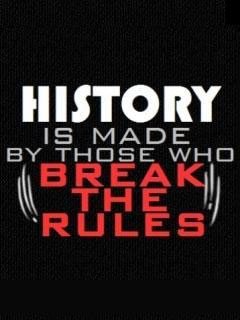
Saturday, 22 June 2013
The Top 5 Successful Men Who Broke The Rules
Mark Zuckerberg
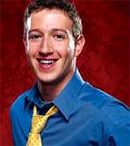 As a co-founder of Facebook, Mark Zuckerberg created one of the most popular services on the internet. As its current CEO and president, his creative control seeks to keep the company on top for years to come.
As a co-founder of Facebook, Mark Zuckerberg created one of the most popular services on the internet. As its current CEO and president, his creative control seeks to keep the company on top for years to come.
Rule Broken: It’s all about the bottom line
Given Facebook’s incredible growth and popularity, many have questioned whether the company could be earning more. In a May interview with Wiredmagazine, he admitted: “Yeah. I guess we could. There are really simple things we could do. For one thing, we keep advertising pretty sparse. If you look at how much of our page is taken up with ads compared to the average search query. The average for us is a little less than 10% of the pages and the average for search is about 20% taken up with ads… that’s the simplest thing we could do. But we aren’t like that. We make enough money. Right, I mean, we are keeping things running; we are growing at the rate we want to.”
Given Facebook’s incredible growth and popularity, many have questioned whether the company could be earning more. In a May interview with Wiredmagazine, he admitted: “Yeah. I guess we could. There are really simple things we could do. For one thing, we keep advertising pretty sparse. If you look at how much of our page is taken up with ads compared to the average search query. The average for us is a little less than 10% of the pages and the average for search is about 20% taken up with ads… that’s the simplest thing we could do. But we aren’t like that. We make enough money. Right, I mean, we are keeping things running; we are growing at the rate we want to.”
In addition, Facebook has passed on purchase offers and even investments of capital, denying itself higher profits and focusing instead on market growth.
Elon Musk
 Elon Musk is the South African entrepreneur who found X.com, later changing its name to PayPal. Through the continued growth of the site, Elon remained the company’s largest shareholder, until the site’s sale to eBay left him a very wealthy man.
Elon Musk is the South African entrepreneur who found X.com, later changing its name to PayPal. Through the continued growth of the site, Elon remained the company’s largest shareholder, until the site’s sale to eBay left him a very wealthy man.
Rule Broken: Stick to what you know
Having navigated a financial website from launch to a substantial buyout, many would assume Musk’s next venture to be related to finance, or at the very least web-based. Instead, Musk currently serves as CEO of two ventures, neither remotely related to his previous field. SpaceX is a company developing vehicles for space transport (rockets and spacecraft meant to move spaceflight forward). His other company is likely one you’ve heard of — Tesla Motors, the company bringing drool-worthy, highway-rated electric cars to market. While both ventures are still establishing themselves, Musk’s companies are poised at the cutting edge of future technology. This position gives him the “make-or-break” chance at changing the world he wouldn’t have gotten by trying to copy his former success.
Having navigated a financial website from launch to a substantial buyout, many would assume Musk’s next venture to be related to finance, or at the very least web-based. Instead, Musk currently serves as CEO of two ventures, neither remotely related to his previous field. SpaceX is a company developing vehicles for space transport (rockets and spacecraft meant to move spaceflight forward). His other company is likely one you’ve heard of — Tesla Motors, the company bringing drool-worthy, highway-rated electric cars to market. While both ventures are still establishing themselves, Musk’s companies are poised at the cutting edge of future technology. This position gives him the “make-or-break” chance at changing the world he wouldn’t have gotten by trying to copy his former success.
Dana White
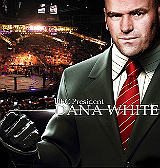 As the current president of the UFC, Dana White has overseen the UFC’s return to popularity and taken it to the next level. White’s management has taken the UFC to pay-per-view, sold-out events and a reality TV show. The former promoter is now the face and voice of the UFC.
As the current president of the UFC, Dana White has overseen the UFC’s return to popularity and taken it to the next level. White’s management has taken the UFC to pay-per-view, sold-out events and a reality TV show. The former promoter is now the face and voice of the UFC.
Rule Broken: Know when to walk away
By the end of the ‘90s, the UFC was struggling. Public perception of the sport was low, and no-holds-barred fighting had been banned in 36 states. With the UFC struggling, its owners were looking to sell. White used his promotional know-how to craft a plan for the UFC. He contacted a wealthy childhood friend who purchased the UFC and installed White as president. Under his leadership, the “dying” sport has seen a resurgence in popularity many major-league teams can only dream of.
By the end of the ‘90s, the UFC was struggling. Public perception of the sport was low, and no-holds-barred fighting had been banned in 36 states. With the UFC struggling, its owners were looking to sell. White used his promotional know-how to craft a plan for the UFC. He contacted a wealthy childhood friend who purchased the UFC and installed White as president. Under his leadership, the “dying” sport has seen a resurgence in popularity many major-league teams can only dream of.
Steve Jobs
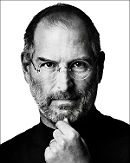 As the co-founder and CEO of Apple, Steve Jobs has been a mover and shaker in the tech industry for decades. After resigning from Apple in the ‘80s, Jobs continued to work in the tech field, until his return to Apple in 1996 spurred the company’s meteoric rise to fame with the iOS line of devices.
As the co-founder and CEO of Apple, Steve Jobs has been a mover and shaker in the tech industry for decades. After resigning from Apple in the ‘80s, Jobs continued to work in the tech field, until his return to Apple in 1996 spurred the company’s meteoric rise to fame with the iOS line of devices.
Rule Broken: Play with the big boys
Throughout his career, Jobs has passed up opportunities to get in bed with larger companies when it didn’t serve his vision. A prominent example was his refusal to make the Mac OS compatible with non-Apple PCs. In his role at Pixar, Jobs was also willing to let the company’s profitable relationship with Disney come to an end when Disney would not agree to his terms. Finally, when he returned to Apple in 1996, the company was far from the titan it is today. With struggling profits and market share, Apple was hardly the most attractive position Jobs could get. All of Apple’s woes, however, were secondary to the vision he had for the company.
Throughout his career, Jobs has passed up opportunities to get in bed with larger companies when it didn’t serve his vision. A prominent example was his refusal to make the Mac OS compatible with non-Apple PCs. In his role at Pixar, Jobs was also willing to let the company’s profitable relationship with Disney come to an end when Disney would not agree to his terms. Finally, when he returned to Apple in 1996, the company was far from the titan it is today. With struggling profits and market share, Apple was hardly the most attractive position Jobs could get. All of Apple’s woes, however, were secondary to the vision he had for the company.
Ferran Adria
 The chef at elBulli, Ferran Adria is listed among the best chefs in the world, often holding the No.1 spot on those lists. His restaurant, elBulli, has been named Restaurant magazine’s No.1 restaurant in the world a record five times (2002 and 2006 to 2009), finishing a more-than-respectable second place in 2010.
The chef at elBulli, Ferran Adria is listed among the best chefs in the world, often holding the No.1 spot on those lists. His restaurant, elBulli, has been named Restaurant magazine’s No.1 restaurant in the world a record five times (2002 and 2006 to 2009), finishing a more-than-respectable second place in 2010.
Rule Broken: Focus on your core business
With that kind of publicity and acclaim, many would expect Adria to be obsessively committed to his work in the kitchen. In fact, elBulli is only open for a limited time each year, typically about six months. The other half of the year is devoted to Adria’s growth as a chef and exploration of new ideas. Reservations for his restaurant are booked on a single day, and the restaurant turns away literally millions of customers each year. In spite of this, the restaurant has operated at a loss for over a decade, relying on sales of books, products and Adria’s income as a presenter. As both the best restaurant and hardest reservation in the world, then, it was no small surprise when Adria announced earlier this year that elBulli would be closing for two years, and that the current format is “finished.” He claims not to have a plan for what’s next, simply telling journalists: “Our challenge is just to find out if there’s anything beyond what we’ve already done.”
With that kind of publicity and acclaim, many would expect Adria to be obsessively committed to his work in the kitchen. In fact, elBulli is only open for a limited time each year, typically about six months. The other half of the year is devoted to Adria’s growth as a chef and exploration of new ideas. Reservations for his restaurant are booked on a single day, and the restaurant turns away literally millions of customers each year. In spite of this, the restaurant has operated at a loss for over a decade, relying on sales of books, products and Adria’s income as a presenter. As both the best restaurant and hardest reservation in the world, then, it was no small surprise when Adria announced earlier this year that elBulli would be closing for two years, and that the current format is “finished.” He claims not to have a plan for what’s next, simply telling journalists: “Our challenge is just to find out if there’s anything beyond what we’ve already done.”
By: Nate Steere
(Video) The DNA Of An Innovator
(Video) Jeff Dyer: Think Like An Innovator
(Video) Hal Gregerson – The Innovator’s DNA
Jeff Dyer, Hal Gregerson & Clayton M Christensen’s Four Ways To Become An Incredible Innovator:
- Ask the right questions. “We all know that questions are important as a catalyst for creative thought,” says Dyer. “But some people are much more inclined to question the status quo, and they tend to ask ‘what if?’ kinds of questions.” One technique that can be used to ask more provocative questions, says Dyer, is to impose constraints. “If you’re looking for innovative ideas on how to grow, you might ask ‘what if we were legally prohibited from selling our projects to any of our current customers? How would we make money next year?’” Or, you might take the Steve Jobs approach and try eliminating constraints by asking “what kind of product would we create if money were no object.” Either way, says Dyer, “creativity loves constraints.”
- Observe what others don’t see. “Some of us do it better than others,” says Dyer. “The kinds of observations that seem to make a difference for business owners are observations of customers and competitors.” Scott Cook of Intuit, for instance, always paid special attention to behavior that was in some way surprising. “The anomalies are the key,” says Dyer. “When you find the surprise, that may lead you to observe something no one has ever seen before, and that can trigger ideas for new businesses.” The best observers, he says, are people who have lived in multiple countries for three months or longer. “You more naturally tend to observe because things are different.”
- Tap the right networks. “Typically people network for the purpose of accessing resources,” says Dyer. “And they want to talk to people like themselves.” But innovators, he says, are more likely to target people who are not like them. Pierre Omidyar, the founder of eBay, frequently noted that he learned more from a mail room employee than from the CEO when visiting a new company. “You want to talk to people who are in different social networks than you are in,” says Dyer. “People not in your industry or in your company are more likely to give you a perspective that you haven’t heard before. The key is to talk to people from other countries, of different ages, political persuasions, and ethnic groups.”
- Be savvy with your experiments. “Richard Branson has had 300 different Virgin businesses,” says Dyer. “Some have worked and some have failed. He is prepared to try anything once.” The idea is that you pilot your ideas quickly, get them out into the marketplace, and not be afraid of failure. There are two other ways to experiment, notes Dyer: 1. Take things apart, then put them back together again. That’s what Michael Dell did with an off-the-shelf computer, and the process gave him the idea for the Dell direct model. 2. Learn a new skill. After Steve Jobs dropped out of Reed College, he decided to take a calligraphy class simply because he was intrigued by the art. Ten years later, that exposure to calligraphy informed Job’s design of the Macintosh, which was the first computer with beautiful typography.
The First 50 Of 101 Amazing Marketing Quotes
The First 50 Of 101 Amazing Marketing Quotes
If you wait until there is another case study in your industry, you will be too late! – Seth Godin (Author Of Permission Marketing)
People share, read and generally engage more with any type of content when it’s surfaced through friends & people they know and trust. – Malorie Lucich (FaceBook Spokesperson)
No matter what, the very first piece of Social Media Real Estate I’d start with is a blog. – Chris Brogan (New Marketing Labs)
Instead of one-way interruption, Web marketing is about delivering useful content at just the right moment that a buyer needs it. – David Meerman Scott (Author Of The New Rules Of Marketing & PR)
Increasingly, mass marketing is turning into a mass of niches. – Chris Anderson (Author Of The Longtail)
When you enchant people, your goal is not to make money from them or to get them to do what you want, but to fill them with great delight. - Guy Kawasaki (Former Chief Evangelist of Apple)
Remarkable social media content and great sales copy are pretty much the same – plain spoken words designed to focus on the needs of the reader, listener, or viewer. – Brian Clark (Copy Blogger)
Next time you hear a Social Media myth, question it, ask for the proof, and ask out loud. – Dan Zarella (HubSpot)
Bring the best of your Authentic Self to every opportunity. - John Jantsch (Author Of Duct Tape Marketing)
There are no magic wands, no hidden tracks, and no secret handshakes that can bring you immediate success, but with time, energy and determination you can get there. - Darren Rowse (Pro Blogger)
Your culture is your brand. - Tony Hsieh (CEO Zappos)
Focus on the core problem your business solves & put out lots of content & enthusiasm, & ideas about how to solve that problem. - Laura Fitton (OneForty.com)
You can’t just ask customers what they want and then try to give that to them. By the time you get it built, they’ll want something new. - Steve Jobs (CEO of Apple)
The biggest mistake we see companies make when they first hit Twitter is to think about it as a channel to push out information. – Tim O’Reilly & Sarah Milstein (The Twitter Book)
Clarity trumps persuasion. – Dr.Flint McGlaughlin (Director, Meclabs)
Don’t be afraid to get creative & experiment with your marketing. – Mike Volpe (HubSpot)
You need the kind of objectivity that makes you forget everything you’ve heard, clear the table, and do a factual study like a scientist would. – Steve Wozniak (Co-Founder Of Apple)
Make the customer the hero of your story. – Ann Handley (Marketing Profs)
The Internet has turned what used to be a controlled, one way message into a real time dialogue with millions. – Danielle Sacks (Fast Company)
In todays information age of marketing and Web 2.0, a company website is the key to their entire business. - Marcus Sheridan (Author Of The Sales Lion Blog)
The way you can understand all of the Social Media is as the creation of a new kind of public space. – Danah Boyd (Social Media Researcher – Microsoft)
Presentations are the most amazing persuasion tool available in organizations today – Nancy Duarte (CEO – Duarte Design)
What makes content engaging is relevancy. You need to connect the contact information with the content information. – Gail Goodman (Constant Contact)
Give them quality, that’s the best kind of advertising – Milton Hershey (Founder Of Hersheys Chocolate)
More contact means more sharing of information, gossiping, exchanging, engaging – in short, more word of mouth. – Gary Vaynerchuck (Author Of The Thank You Economy)
Think about what a user is going to type. – Matt Cutts (Google)
For corporate marketers pod-casting is low hanging fruit. – Paul Gillin (The New Influencers)
Video is just one part of a marketing plan. It fits certain messages & people better than others. –Steve Garfield (Author Of Get Seen)
Instituations that once had to go through media to deliver information are now themselves media -Andrew Nachison (Founder We Media)
Before you create anymore “great content”, figure out how you ae going to market it first. – Joe Pulizzi & Newt Barrett (Authors Of Get Content, Get Customers)
If you have more money than brains, you should focus on outbound marketing, If you have more brains than money, you should focus on inbound marketing. - Guy Kawasaki (Former Chief Evangelist Of Apple)
People shop and learn in a whole new way compared to just a few years ago, so marketers need to adapt or risk extinction. - Brian Halligan (Co-Author Of Inbound Marketing)
Understand why and how your audience uses technology and then start trying to align your communications efforts. - Brian Reich & Dan Solomon (Authors Of Media Rules)
Audiences everywhere are tough, they don’t have time to be bored or brow beaten by orthodox, old fashioned advertising. - Craig Davis
The attention economy is not growing, which means we have to grab the attention that someone else has today. – Brent Leary (Co-Founder of CRM Essentials)
We have embarked upon the world’s largest and longest cocktail party, and every issue imaginable is up for grabs. – Geoffrey Moore (Author Of Dealing With Darwin)
Social Media are tools, Real Time is a mindset. - David Meerman Scott (Author Of The New Rules Of PR & Marketing)
Increasingly, search is our mechanism for how we understand ourselves, our world, and our place within it. – John Battelle (Founder, Federated Media Publishing)
Either write something worth reading or do something worth writing about. – Benjamin Franklin
Search, a marketing method that didn’t exist a decade ago, provides the most efficient and inexpensive way for businesses to find leads. - John Battelle (Founder, Federated Media Publishing)
For the past 10 years, corporations have been trained that they should use all the different media… But the internet is becoming the umbrella. – Larry Weber (Author Of Marketing To The Social Web)
Doing well with blogging is not about writing one key post, it is about performing day after day and helping a few people at a time. – Aaron Wall (Author Of The SEO Book Blog)
You can’t expect to just write and have visitors come to you – that’s too passive. – Anita Campbell (Founder & CEO Of Smallbiztrends.com)
Word of mouth marketing has always been important. Today, it’s more important than ever because of the power of the internet. - Joe Pulizzi & Newt Barrett (Authors Of Get Content, Get Customers)
In a way, the web is like your Hollywood agent: It speaks for you whenever you are not around to comment - Chris Brogan & Julien Smith (Authors Of Trust Agents)
For business, our internet love affair was a gift from the gods. – Gary Vaynerchuk (Author Of The Thank You Economy)
Corporations must answer questions about why they should be in the blogosphere. Small Businesses need to answer questions about why they shouldn’t. – Paul Gillin (Author Of The New Influencers)
Good content should be at the heart of your strategy, but it is equally important to keep the display context of that content in mind as well. – Tim Frick (Author Of Return On Engagement)
No Matter what or who’m we’re talking about, from movies to chiropractors to books to financial planners, the consumer hankers after specialization. – Susan Friedmann (Author Of Riches In Niches)
7 Steps To Finding Your ‘Passion’ – The Secret Ingredient To Success
True happiness and success comes when you do what you are most passionate about! One of the biggest things that most of us lack is passion. Ask any successful person, entrepreneur, millionaire and they will all tell you the same thing; you must be passionate about what you do! A recent survey shows that 75% of the population do not know what their true passion is. Perhaps this is why there is so much unhappiness in our society for to be truly happy, you have to really love and be passionate about what you do.
Here is a list of 7 things you need to ask and answer for yourself to help you find and understand what you are passionate about.
What puts a smile on your face?
Following what makes you truly happy is a wonderful way to figuring out what you were put on Earth for. Think about something that you do or that perhaps you used to do that brings you total happiness!
What do you find easy?
What we find easy for us to do, will be related to what we are passionate about. It’s very hard to hate something that is very easy for us!
What we find easy for us to do, will be related to what we are passionate about. It’s very hard to hate something that is very easy for us!
What sparks your creativity?
Think about something in your life where you seem to always expand its horizon, always coming up with new, fun, and exciting ideas relating to that subject. Whatever makes you creative is something that you are passionate about.
Think about something in your life where you seem to always expand its horizon, always coming up with new, fun, and exciting ideas relating to that subject. Whatever makes you creative is something that you are passionate about.
What would you do for free?
Think about something that you would just love to do, even if you were not getting paid. Think about something that you look forward to do, something that you wish you could do all the time
Think about something that you would just love to do, even if you were not getting paid. Think about something that you look forward to do, something that you wish you could do all the time
What do you like to talk about?
Most of the time, we aren’t aware of this. A good way to figure this out properly, is to ask your friends. Ask them what they believe you like to talk about the most, what topic makes your eyes brighten up, and changes your entire behaviour.
Most of the time, we aren’t aware of this. A good way to figure this out properly, is to ask your friends. Ask them what they believe you like to talk about the most, what topic makes your eyes brighten up, and changes your entire behaviour.
What makes you unafraid of failure?
When you do what you are passionate about, you have total confidence in your abilities. This makes you not worry about failing, because in your mind, how can you fail when you do what you love?
When you do what you are passionate about, you have total confidence in your abilities. This makes you not worry about failing, because in your mind, how can you fail when you do what you love?
What would you regret not having tried?
If you were at the end of your life, what would you regret not having pursued? What would you have liked to do, that you didn’t get a chance to?
If you were at the end of your life, what would you regret not having pursued? What would you have liked to do, that you didn’t get a chance to?
Watch this video below, a compilation of the greats sharing their advice on the importance of finding your Passion!
(Video) Follow Your Passion
101 Amazing Quotes About Marketing Pt.2
The right people to start video blogging are those with a passion to tell a story. – Steve Garfield (Author Of Get Seen)
I am all for conversations. But you need to have a message. – Renee Blodgett (Blodgett Communications)
Your network is your filter. – Don Tapscott & Anthony D Williams (Authors Of Wikinomics)
When you’ve got people commenting on your stuff or calling you out or challenging you – you have to be prepared to guard yourself from being something that isn’t you – David Armano (Edelman Digital)
No matter your sector, chances are that people are already twittering about your products, your brand, your company or at least your industry. - Tim O’Reilly & Sarah Milstein (The Twitter Book)
What happens online is you are constantly dealing with invisible audiences. – Danah Boyd (Social Media Researcher – Microsoft)
Twitter is not a technology. It’s a conversation and it’s happening with or without you. – Charlene Li (Co-Author Of Groundswell)
To trust agents, hyperlinks are the twenty-first-century equivalent of the name-dropper. – Chris Brogan & Julien Smith (Authors Of Trust Agents)
Good-bye broadcast, Hello, conversation. – Shel Israel (Co-Author Of Naked Conversations)
Marketers need to build digital relationships and reputation before closing a sale. – Chris Brogan (New Marketing Labs)
As you’ve noticed people don’t want to be sold. What people do want is news and information about the things they care about. – Larry Weber (Author Of Marketing To The Social Web)
You wan’t to invent new ideas, not new rules. – Dan Heath (Co Author Of Made To Stick)
Businesses should follow and learn from others successes and failures in order to better understand and predict their own. – Ben Mezrich (Author Of The Accidental Billionaires)
Companies are learning that it’s much better to offer customers a place to give direct feedback at their virtual doorstep than to ignore complaints and let them crop up everywhere – Brian Reich & Dan Solomon (Authors Of Media Rules!)
To be successful and grow your business and revenues, you must match the way you market your products with the way your prospects learn about and shop for your products. – Brian Halligan (Co Author Of Inbound Marketing)
Smart phones are re-inventing the connections between companies and their customers. – Rich Miner (Co Founder Of Android)
Understand the key factors in the math behind viral marketing, and use those to figure out what it takes to get viral growth. – David Skok (Matrix Partners)
You’ve probably got a device on you that can shoot decent video, so what’s stopping you? –Steve Garfield (Video Blogger)
Think like a customer – Paul Gillin (Author Of The New Influencers)
Effective engagement is inspired by the empathy that develops simply by being human. – Brian Solis (Author Of Engage)
From Sixdegrees to Friendster to Facebook, Social Networking has become a familiar and ubiquitous part of the Internet. – David Kirkpatrick (Author Of The Facebook Effect)
We’re all learning here; the best listeners will end up the smartest. – Charlene Li & Josh Bernoff (Authors Of Groundswell)
Marketing isn’t magic, there is a Science to it. – Dan Zarrella (Social Media Scientist)
Holding back technology to reserve business models is like allowing blacksmiths to veto the internal combustion engine in order to protect their horseshoes. – Don Tapscott (Wikinomics)
The future of business is social. – Barry Libert (Author Of Social Nation)
Keep your eye out for hot topics and trends. The media is constantly looking for timely stories. -Jim Kukral (Author Of Attention!)
Traditional methods of sales prospecting are grossly inefficient. – Jill Konrath (Author Of Snap Selling)
I can take what I learned from writing articles, educate a new audience with a new channel, and leap frog other companies who aren’t embracing this now. – Brian Carroll (CEO, InTouch)
By publishing content that shows buyers you understand their problems and can show them how to solve them, you build credibility. – Ardath Albee (Author Of EMarketing Strategies For The Complex Sale)
Already, companies that speak in the language of the pitch, the dog-and-pony show, are no longer speaking to anyone. – The Clue Train Manifesto
Authenticity, honesty and personal voice underlie much of what’s successful on the web. – Rick Levine (Cluetrain Manifesto)
Your organization is becoming hyperlinked. Whether you like it or not. It’s bottom-up; it’s impossible. – David Weinberger (Everything Is Miscellaneous)
When all you’ve got is a hammer, bad service looks like a nail. – Doc Searls (The Cluetrain Manifesto)
Take two ideas and put them together to make one idea. After all, what is a Snuggie but a mutation of a blanket and a robe? – Jim Kukral (Attention!)
Recognize that give away items serve as silent ambassadors, reinforcing your Expert Identity – choose them carefully. – Susan Friedmann (Author Of Riches In Niches)
Money follows Passion – not the other way around. – David Garland (Rise To The Top)
For many businesses, the fear behind their social media reluctance isn’t just fear of failure but of blame and accountability – both individual and collective. – Jay Baer (The Now Revolution)
Companies need to lighten up and take themselves les seriously. They need to get a sense of humor. - The Cluetrain Manifesto
Until Facebook came along, there was hardly anywhere on the public internet where you had to operate with your real name. – David Kirkpatrick (Author Of The Facebook Effect)
By listening, marketing will re-learn how to talk. - Doc Searls (The Cluetrain Manifesto)
Companies need connections to their markets to create long-term loyalty. - Charlene Li & Josh Bernoff (Authors Of Groundswell)
There’s a lot of fear-mongering about “losing control” of your brand online, when, in fact, you’ve got control over as much as you always have: how you present your business and how you act. - Jay Baer (The Now Revolution)
Be passionate about the culture and the business, and remain positive, because it inspires others. – Barry Libert (Author Of Social Nation)
Good is the enemy of great.. The vast majority of good companies remain just that – good, but not great. – Jim Collins (Author Of Good To Great)
Those who build and perpetuate mediocrity…are motivated more by the fear of being left behind. - - Jim Collins (Author Of Good To Great)
One way to sell a consumer something in the future is simply to get his or her permission in advance. – Seth Godin (Author Of Permission Marketing)
In this age of micro-blogging and two second sound bites, almost no one has the attention span, or time, to read more than a few sentences. – Tim Frick (Return On Engagement)
Once you have your questions and stories, map them to the buying process – just as your prospect will experience them. - Ardath Albee (Author Of EMarketing Strategies For The Complex Sale)
What we really need is a mindset shift that will make us relevant to todays consumers, a mindset shift from telling to selling to building relationships. – Jim Stengel (Procter & Gamble)
It no longer makes economic sense to send an advertising message to the many in hopes of persuading the few. – M Lawrence Light (Former Chief Marketing Officer Of McDonalds)
When you break down all the fluff, there are two ways to promote and market your business, dumber, slower and expensive – or faster, smarter and cheaper. - David Garland (Rise To The Top)
There is no black magic to successfully attracting customers via the Web. – Rand Fishkin (Founder, SEOMOZ)
The 7 Habits of Highly Innovative People
Habit 1: Be Passionate. Finding your passion is not only the key to happiness, but also the key to business success. As Steve Jobs once said, “Your time is limited, so don’t waste it living someone else’s life. The only way to do great work is to love what you do. If you haven’t found it yet, keep looking. Don’t settle.” (Be Proactive)
Habit 2: Do Something. You don’t always know where it’s going to lead, but it’s always better to do something than to suffer analysis paralysis. Legendary oil-man and entrepreneur T. Boone Pickens has a way of quickly sizing up a situation, coming up with a plan, and acting. There’s no sitting around or endless analysis and debate. It seems to have worked for him. (Begin with the End in Mind)
Habit 3: Put First Things First, Second, and Third. Covey says prioritize, but I’ll take it one step further. Whoever said, “don’t sweat the small stuff,” was right, and I’ll add, “don’t do or even think about the small stuff.” Every successful innovative person I know jumps on hot opportunities and critical issues like they’re the only things that matter on god’s green Earth. (Put First Things First)
Habit 4: Think Win. Former New York Yankees owner George Steinbrenner may have been a world-class a-hole, but he was a remarkably rich and successful world-class a-hole who let nothing stand in the way of the only thing that ever really mattered to him, winning. Bill Gates, Larry Ellison – show me a successful entrepreneur and I’ll show you someone who puts winning first.(Think Win/Win)
Habit 5: Seek First to Understand, then to Innovate. The key to innovation is to first understand a big hairy problem that, to date, nobody’s been able to solve. Once you’ve got that, then, and only then, does it even begin to make sense to do something about it. Otherwise you’ll just end up with a great product nobody needs. (Seek First to Understand, then to be Understood)
Habit 6: Energize. With rare exception, successful innovators are high-energy people with a unique ability to stimulate and motivate others. That’s called leadership. Without it, you can have the most effective habits or the best ideas in the world, but nobody will ever know it, because nobody will care and nothing will actually get done. (Synergize)
Habit 7: Question the Status Quo. Andy Grove built semiconductor powerhouse Intel on several principles, two of which were “only the paranoid survive” and “constructive confrontation.” That means never rest on your laurels, continually challenge your own assumptions, and always question the status quo. That’s how Intel became a high-tech dynasty. (Sharpening the Saw)
The Amazing Life That Steve Jobs Lived

Steve Jobs died on October 5, 2011 at the age of 56. He was an amazing Visionary & entrepreneur, fighting a battle with cancer. He had battled the disease for years, took medical leave from Apple in January and stepped down as chief executive in August because he could “no longer meet (his) duties and expectations.”
To recognize his accomplishments, we have a compiled best of the best right here. He will be missed.
R.I.P Steve Jobs
Steve’s Childhood Home

Steve was born in 1955, was adopted, and as his official bio reads, “grew up in the apricot orchards which later became known as Silicon Valley.”Here’s the house where Apple later began.
Steve Meets Steve

Jobs met Apple cofounder Steve Wozniak, who was four years ahead of him at Homestead High, and the two quickly became friends, sharing stories of pranks they’d pulled.One elaborate prank — flipping off a high school graduating class with a big, tie-dyed, middle finger salute-painted sheet, signed “SWAB JOB” — never quite worked. “Steve got in trouble,” Wozniak wrote in his bio,iWoz.
Portrait Of A Young Nerd
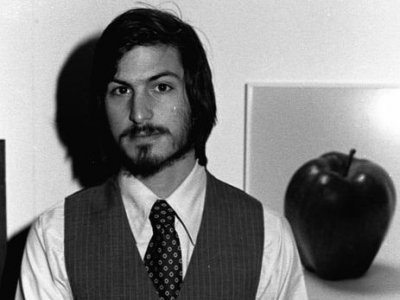
Jobs had an early appreciation for facial hair. This will become an on-again, off-again trend.
Jobs and Wozniak, 1975
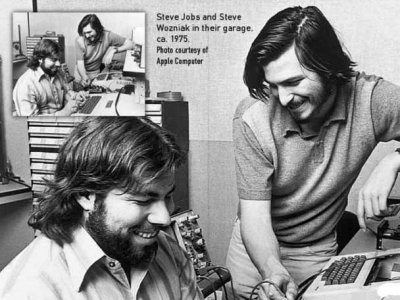
Jobs attended after-school lectures at HP, where Wozniak worked, and got a summer job there.But it wasn’t until the mid-70s — after Steve attended and dropped out of Reed College and traveled to India — that he started attending Wozniak’s “Homebrew Computer Club.”
Apple’s Early Days

To get Apple off the ground, Steve and Steve “sold their most valuable possessions.”Jobs “sold his Volkswagen micro-bus and Wozniak sold his Hewlett-Packard scientific calculator, which raised $1,300 to start their new company.”
Think

Note the “Think” sign behind Steve the hippie.Later, Apple’s slogan changed to Think Different. Steve “always had a different way of looking at things,” his high school electronics teacher said.
The Moustache
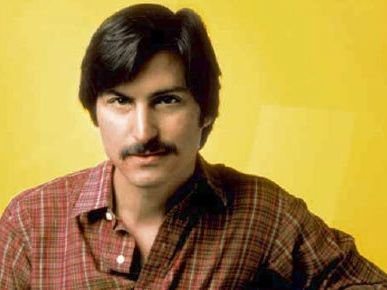
Would you trust this guy to make your computer? You should.
The Mac is Born
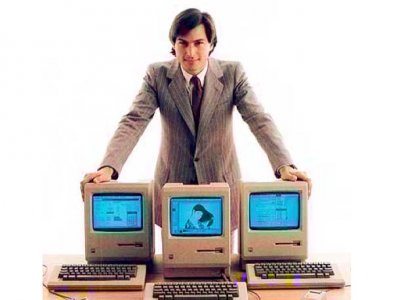
In 1984, Steve rolled out the Mac. It was the first personal computer driven by a graphical user interface. Now they all are.Here’s Apple’s famous “1984″ Super Bowl commercial.
http://www.youtube.com/watch?v=OYecfV3ubP8&
NeXT

Steve got fired from Apple and started a new company called NeXT.The hardware side was a bust, but the software would eventually become the basis for Apple’s OS X — which runs today’s Macs, iPhones, and the iPod touch. (Apple bought NeXT in 1997.)
Peak Hair

At NeXT, Steve went with the hockey player look.
Steve and Laurene

Steve married Laurene Powell in 1991. The couple has three children.
Pixar’s Toy Story

Steve’s first hit of the 90s wasn’t a computer, but a movie.Jobs bought Pixar, an animation studio, from George Lucas in 1986.
In 1995, Toy Story started Pixar’s streak of hits, grossing over $191 million in the U.S. and Canada during its initial box office release. Pixar’s IPO added a cool billion to Steve’s net worth.
Macworld ’98

After Apple bought NeXT, Steve gradually got closer to Apple.In early 1998, Steve Jobs had cultivated a woodsy look. Here he is at Macworld in January, where he announced that beat-up Apple made a $45 million profit the prior quarter.
The iMac: Hello (again)

Later that year, Steve unveiled the iMac, Apple’s Internet-focused computer that — controversially — shipped with no floppy drive. (And was Apple’s first computer to use USB.)”It looks like it’s from another planet,” Steve said. “And a GOOD planet!”
Here’s the video:
The Gulfstream

In 2000, Jobs got 10 million stock options and a Gulfstream V airplane “in recognition of his service to the company.”You can see photos of it around California at Airliners.net.
Photo: S.C. Rubke
iPod, Therefore i Am
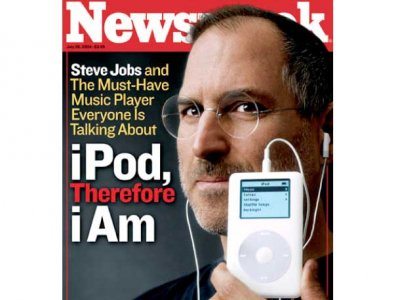
The iPod was Jobs’s biggest game-changer (so far) at Apple.Not only did Steve dominate one industry — portable music players — but he helped totally shake up another — the music business.
Steve and Bono

Steve isn’t just friends and product partners with U2 frontman Bono.He also sold him an apartment in the star-studded San Remo co-op building on Manhattan’s Upper West Side.
‘Stay Hungry. Stay Foolish.’
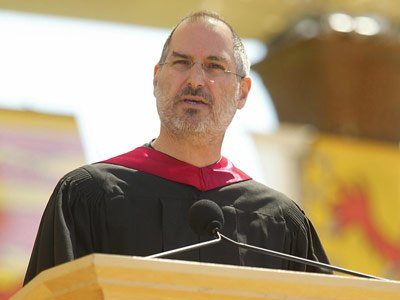
Perhaps Steve’s most famous speech was his Stanford Commencement speechin 2005.He talked about his life as a college dropout, his entrepreneurship, and his battle with cancer.
He ended with a quote from the last edition of The Whole Earth Catalog: “Stay Hungry. Stay Foolish.”
Here’s the video:
Paul Otellini’s Bunny Suit

One of Steve’s greatest coups: Getting Intel CEO Paul Otellini to walk out on stage at Macworld 2006 in an Intel “bunny suit.”That’s when Steve announced that Apple was switching its product line over to Intel chips.
The iPhone, 2007
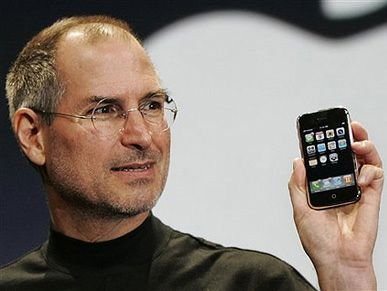
Steve’s best product showmanship at Apple came in January, 2007, when he unveiled the iPhone.Perhaps the best part is when he prank called a Starbucks while showing off the phone’s Maps app. “I’d like to order 4,000 lattes to go, please. No, just kidding — wrong number.”
Here’s a video (part one) of Steve unveiling the iPhone.
Steve’s 2009 medical leave and return

Jobs took a medical leave in 2009, and received a liver transplant in Memphis. Last year, he spoke out in favor of a bill that could boost organ donation in his home state of California.
The iPad
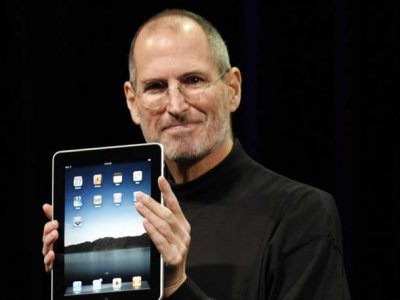
In January, 2010, Jobs unveiled the iPad, an inexpensive tablet computer. It blew past peoples’ wildest expectations, with almost 15 million sold last year.
Earlier this year, Jobs stepped down again for health reasons.
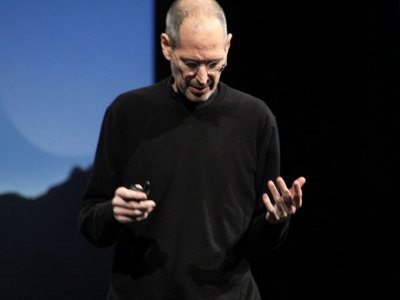
Image: Dan Frommer, Business Insider
Dinner with President Obama

Image: Flickr/White House
Last week, Jobs and Facebook CEO Mark Zuckerberg got to sit next to President Obama at dinner in Silicon Valley. Sweet!Happy birthday, Steve. Feel better!
In one of his last acts as (non-acting) CEO, he presented some amazing plans for a new headquarters building.

Article by BusinessInsider.com
Subscribe to:
Comments (Atom)


